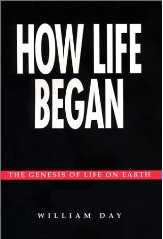The author presents a compelling hypothesis about the origin and evolution of cellular life. He postulates that the cell was founded and evolved on two principles: a) growth sustained by an input of energy, and b) systems based on autocatalysis. The cell became a network of interlinked autocatalytic systems in which the product of one system became reactants for a succeeding system, linking them in a product/reactant dependence.
The first self-sustaining and reproductive cell consisted of an autocatalytic network of coenzymes. The genetic system then originated in the metabolic cell on the cell's metabolites of nucleotides and amino acids. An RNA replicating system composed of catalytic RNA molecules formed, a translation mechanism evolved from its RNA products, and proteins produced by the system became enzymes that supplanted the catalysts of all the preceding systems.
The genetic system began, therefore, as a parasite, became a symbiont, and eventually merged with the metabolic cell into a fully integrated biological cell based on enzymes.
Perhaps this book's most important contribution is that it challenges the basic assumptions researchers have been following unsuccessfully in the origin of life studies, and replaces them with two fundamental principles. Like laws of physics, principles remain constant while expression of them changes. The author contends that life originated on these principles and evolved consistently with them. - The Publisher



